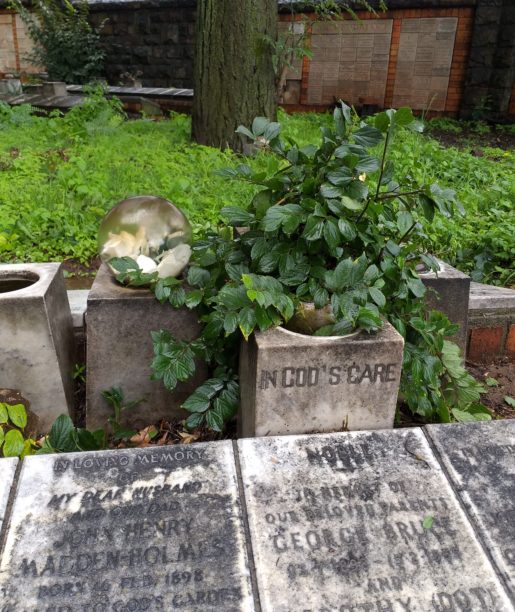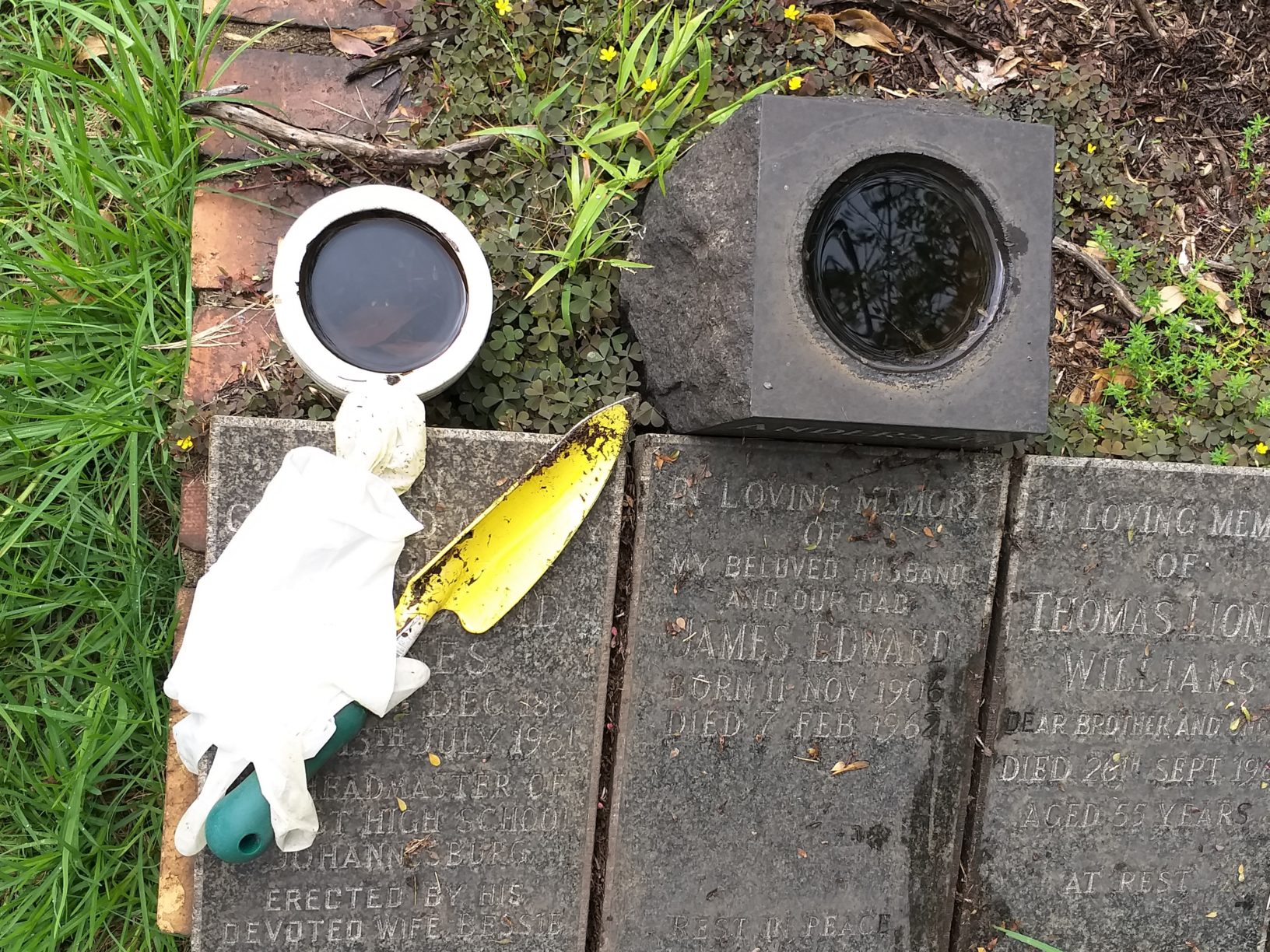When I visited Braamfontein Cemetery recently, the Uber driver who picked me up congratulated me for requesting my trip from inside the graveyard because, if I was outside, I’d be “robbed, raped, and killed” by the houseless people who hang out around the entrance. After that, he grabbed my shoulders and asked if I was a ghost. He’d never been to the cemetery and the place scared him. I regretted sitting in the front seat.
I had gone to the cemetery to meet a group called Friends of the Cemeteries that’s engaged in conserving cemeteries. Braamfontein Cemetery is Johannesburg’s oldest cemetery and it has been badly neglected. While the city’s by-laws specify that the park department should keep the cemeteries clean, Gauteng has thirty five cemeteries and three crematoria, and not enough workers to take care of these spaces. Too, according to the park department, families of the deceased should take care of gravestones and plaques. But many families have left Johannesburg and others have died out. Friends of the Cemetery provides care where it can.
Friends of the Cemetery was founded by Sarah Welham, Flo Bird, and Clare van Zwietzen in 2018. The three belong to the Johannesburg Heritage Foundation, which organises tours around the city to highlight its history. Staffed by volunteers, Friends of the Cemetery offers tours of the cemeteries, performs light maintenance, and coordinates with the city park department for major maintenance. Sarah explains, “We approached City Parks last year and were granted permission to start the group in September. We work in partnership with City Parks where we ask them to do specific jobs like cutting back trees or clearing the areas between the graves, when we have a tour.” The group hopes to encourage people and birdlife to frequent cemeteries, especially as cemeteries are an “important part of the city’s history.”
When it comes to South Africa, history is vexed and contested, and efforts to narrate Johannesburg’s history inevitably come up against the question of whose history is preserved in what spaces.
When I signed up for a tour to learn more about the Friends of the Cemetery, I received clear instructions from Sarah. “We will be weeding around the ash walls and removing ivy so please bring secateurs, loppers, gloves, and black bags,” her email read. I had no idea where the ash walls were, or what that even meant. I had only been to the cemetery once before, to visit the grave of Valliamma Munuswamy and the Enoch Sontonga Memorial.

Located on the corner of Braamfontein, a relentlessly noisy district, the cemetery is shrouded in indigenous trees that muffle the noise. In a busy city, it’s unsettling when things get quiet. Standing amongst the graves and cremation plaques engraved with the words “Rand Pioneer” gave me the creeps. I wondered if the ghost of a Randlord buried here would stop me in my tracks.
Randlords is the name given to early white industrialists and mining bosses, property developers, and art collectors who dominated during the 1890s as the price of gold skyrocketed. Before settling in Johannesburg, they made their money through owning diamond fields in Kimberley. These infamously rich families made money around the same time (1850s to the early 1900s), reinforcing the migrant labour system by creating corporations through gold mining and diamond manufacturing. Their imprint as “titans of industry” is felt in Joburg, with its phallic structures dedicated to the stock market and banks. To know Joburg as the ‘City of Gold’ is to inextriably tie it to the Randlords’ gluttony. Cecil Rhodes, Samuel Marks, and Ernest Oppenheimer are counted in this group of white monopoly capitalists.
At the beginning of March, I joined Friends of the Cemeteries for their second cleaning mission. It had been raining for a solid week before we met, so I wore a pair of Mr. Price Gumboots and carried a small trowel to work in the cemetery. Along with the coordinator—Sarah Welham—seven of us offered our Saturday morning to the Randlords.

None of us had any familial ties to the cemetery but we worked hard to clean and weed plaques. I struck up a conversation with another volunteer, a woman close to my age. I think we both wondered why there was another person under retirement age spending their Saturday cleaning a cemetery. She was a business journalist who went on a previous tour hosted by the Johannesburg Heritage Foundation, and thought to come to the cemetery because she hadn’t been there before.
The layout of the cemetery reflects (proto)-apartheid spatial planning: the main entrance is dedicated to moneyed whites, then poorer whites and white miners or soldiers behind them. Wealthier families, such as the Jeppes, have their own section with gothic angels covered in moss looking after their headstones. The Jewish graves, on the right of the main road into the cemetery, act as a buffer section to the Black, Indian, and East Asian sections, placed furthest from the main entrance. There are separate entries to the Muslim section and Jewish section. Class is complicated by race, and regardless of a black or brown person’s stature, they were placed in their race’s section.
The architecture of the gravestones changes as you wander deeper into the cemetery. In the front, you see faded marble, some bookplates on graves, and intricate hand etchings. And further in the back, besides the Enoch Sontonga Memorial in glossy black stone, the headstones are either poorly etched, illegible, or nonexistent.
When land was allocated to the building of the cemetery in 1887, the city had needed a place to bury the dead for some decades, especially because mining related deaths—people falling into open shafts or machinery killing people—were relatively common in early Johannesburg.
In 1896 a train carrying dynamite exploded in Braamfontein – people, donkeys, and horses were killed, and the city council erected a memorial in the new cemetery. The inscription on the monument reads: “The number who met their sad death from this cause, both white and coloured was 75.” This is one of the few openly multiracial memorials in the cemetery. Memorials for the Anglo-Boer war and the World Wars focus on white combatants, though a 1902 memorial on Observatory Ridge commemorates Black and Indian Army contributions in the Anglo-Boer War. The monuments built in the cemetery reflect the colonial and apartheid policy of the city council, who commissioned the making of the memorials. In death, race is still an inescapable social reality.
The tour I attended focused on the sections up front, nearest to the crematorium, and so to my dismay I cared for dead racist people, some of whom orchestrated the deaths of the people further down the cemetery. Tending to these parts of history is painful. Sometimes, Sarah would tell us quirky facts about a person buried in the area—sometimes an Englishman, other times a Boer—and I wondered what life stories or obscure facts could be given about the people with unmarked or broken or pauper graves. What about their lives? Who tended to them?
The crematorium was busy that morning, so as we weeded lantana and removed gelatinous-looking worms from the plaques, the smell of burning bodies overwhelmed me. Sarah and S.J. de Klerk, another volunteer, who has written prolifically about cemeteries of South Africa for the Heritage Portal website, joked about it. Two cremations later, we had weeded most of the plaques to the left of the crematorium.
According to City Parks, their idea for the cemeteries under their custodianship is this: “The legacy, for Johannesburg City Parks, continues to honour those who have passed before us, by creating green, treed havens within the City, where the living can preserve their memories into the future.” They further mention that newer cemeteries in Midrand and Diepsloot champion the idea of “cemeteries for the living…designed with a more park-like Afrocentric theme.”
Braamfontein cemetery is arrogantly Eurocentric, but as I left, I saw a person laying down some flowers at a Pioneer grave, and the place felt slightly less spooky.
Youlendree Appasamy






